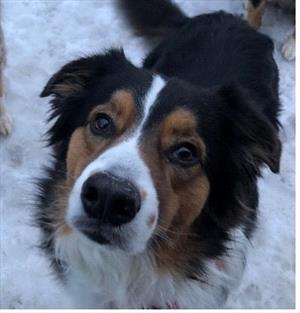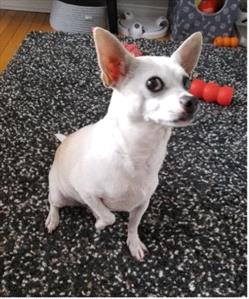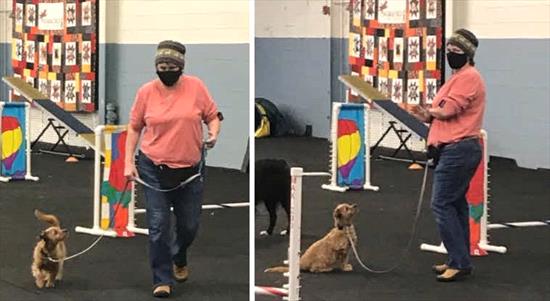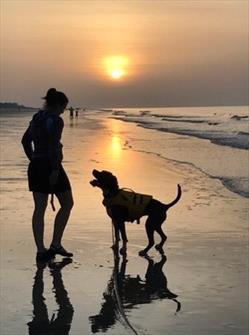Pat Koven, LVT, KPA-CTP; Sandra Robins, BS, CVT, VTS (anesthesia & analgesia), CPDT-KSA, KPA-CTP; Katharine Schwarz, RVT, KPA-CTP
Eye Contact

Photo courtesy of Pat Koven, LVT, KPA-CTP.
Eye contact teaches your pet to focus attention on you and check in with you regularly. By reinforcing this behavior, you are making yourself more exciting than the environment around you. A strong Look on cue is useful:
- to call your dog to you in a dog park or daycare.
- to redirect your dog’s attention away from triggers.
- to help with loose leash walking.
- to teach your dog good things happen by looking at you.
- to use as a fun alternative to leave it.
- to strengthen the bond with your dog.
Instructions
- Choose a marker. This is a word or clicker that signals to your dog they have demonstrated the desired behavior. This marker word could be a word like, Yes!
- Begin in a quiet room. Sit quietly in a chair, with tasty treats ready to reinforce your dog.
- As your dog looks at you, mark with a clicker or say Yes! and give a treat. Repeat several times. If your dog does not make direct eye contact, reinforce first for looking in your direction, then at your body, then your face, then your eyes. Some dogs may feel excessively uncomfortable with direct eye contact, looking at you in general is an acceptable alternative.
Worried Dog

This dog appears worried about direct eye contact. Note the whites of his eyes, body turned away and paw raised.
Photo courtesy of Katharine Schwarz, RVT, KPA-CTP.
- Choose a cue word to name this behavior for your dog, such as Look, or Watch.
- Once your dog is making eye contact routinely, add your cue as soon as your dog looks at you.
- Test your cue after several repetitions. If your dog looks at you, mark, and reward. Repeat until reliable.
Adding Distance
Once your dog learns the cue, you can start to add some distance between you and your dog. Step a few feet away and cue the behavior. Gradually increase your distance.
Adding Duration
To lengthen the time your dog makes eye contact with you, gradually increase the time between marks. Randomly increase the time between marks, one second, two seconds, back to one second, then three seconds, so your dog doesn’t learn a pattern.
Photo courtesy of Sandra Robbins

Photos courtesy of Sandra Robbins BS, CVT, VTS (anesthesia & analgesia),CPDT-KSA, KPA-CTP.
Photo courtesy of Sandra Robbins

Photo courtesy of Sandra Robbins BS, CVT, VTS (anesthesia & analgesia),CPDT-KSA, KPA-CTP.
Adding Indoor Distractions
- Start with low level distractions, to keep your dog from getting too excited to pay attention.
- Practice inside your house, cue a Look every so often as you go about your daily routine.
- At mealtime, cue this behavior before putting a meal down.
- Cue this behavior before opening the door.
Adding Outdoor Distractions
- Add higher level distractions by asking for eye contact on your daily walks or on car rides.
- Practice in busier outdoor environments.
Make It Fun
Eye contact should be a fun activity for your dog. With practice, your dog will look to you for guidance, no matter the surroundings. They learn to focus less on the world around them.
Reward often.